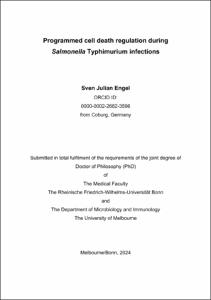Programmed cell death regulation during Salmonella Typhimurium infections
Programmed cell death regulation during Salmonella Typhimurium infections
| dc.contributor.advisor | Garbi, Natalio | |
| dc.contributor.author | Engel, Sven Julian | |
| dc.date.accessioned | 2024-01-18T15:04:45Z | |
| dc.date.issued | 18.01.2024 | |
| dc.identifier.uri | https://hdl.handle.net/20.500.11811/11250 | |
| dc.description.abstract | Programmed cell death (PCD) is a highly regulated process that is vital for the development and homeostasis of multicellular organisms. It functions as an essential mechanism to remove dispensable or unfavourable cells in a coordinated manner under physiological as well as pathophysiological conditions. Importantly, this type of cellular suicide also serves as an effective defence strategy to control intracellular pathogens that aim to repurpose host cells as replicative niche and to evade extracellular immune responses. Recent findings indicate that host cells utilise multiple PCD pathways to fight invading pathogens. However, the organisation and regulation of this complex cell death network consisting of pyroptosis, apoptosis and necroptosis and their relative importance for the control and clearance of intracellular infection is not completely understood. In this thesis, we systematically investigated the cellular and molecular requirements for PCD induction and the contribution of different PCD pathways to immunity against intracellular bacteria. We infected novel genetically modified mouse strains deficient for various combinations of PCD mediators, such as different cysteine-dependent aspartate-directed proteases (caspases), with the bacterial model organism Salmonella enterica serovar Typhimurium (S. Typhimurium) to analyse their ability to control intracellular infections. Additionally, we established in vitro assays to disentangle the complex interactions of the PCD network by analysing the cell death kinetics of bone-marrow derived macrophages obtained from various mouse strains in real-time and determining the intracellular bacterial burden following infection with S. Typhimurium. Our findings unveiled that the PCD pathways pyroptosis and apoptosis are highly interconnected and regulated with a remarkable level of redundancy. We identified that pyroptosis and apoptosis are essential for the control of S. Typhimurium and that molecular components of these pathways, such as caspase-1 and -8, can be used interchangeably to counteract bacterial evasion strategies. Furthermore, we investigated the underlying mechanisms that coordinate the flexible induction of pyroptosis and apoptosis during S. Typhimurium infection. We demonstrated that caspase-2 neither plays a significant primary nor compensatory role in the regulation of cell death and control of intracellular infections. Upon excluding caspase-2 as link between PCD pathways, we evaluated means of extracellular cell death induction. The results presented in this thesis imply critical functions for cytotoxic CD4+ T cells and interferon gamma (IFN-γ) in extrinsic apoptosis induction of S. Typhimurium infected cells. In conclusion, our results highlight the relative importance, interconnectivity and redundancy of different PCD pathways. This study provides detailed insights into the highly complex network of PCD by unravelling new functions for several of its components and thereby defining novel mechanisms of cell death induction during infections with S. Typhimurium. These findings aid to discover new drug targets and develop novel treatment strategies to fight intracellular infections by enhancing essential host immune responses. | en |
| dc.language.iso | eng | |
| dc.rights | In Copyright | |
| dc.rights.uri | http://rightsstatements.org/vocab/InC/1.0/ | |
| dc.subject | Programmed Cell Death | |
| dc.subject | Pyroptosis | |
| dc.subject | Apoptosis | |
| dc.subject | Necroptosis | |
| dc.subject | Caspases | |
| dc.subject | Salmonella Typhimurium | |
| dc.subject.ddc | 570 Biowissenschaften, Biologie | |
| dc.subject.ddc | 610 Medizin, Gesundheit | |
| dc.title | Programmed cell death regulation during Salmonella Typhimurium infections | |
| dc.type | Dissertation oder Habilitation | |
| dc.publisher.name | Universitäts- und Landesbibliothek Bonn | |
| dc.publisher.location | Bonn | |
| dc.rights.accessRights | embargoedAccess | |
| dc.date.embargoEndDate | 01.02.2026 | |
| dc.identifier.urn | https://nbn-resolving.org/urn:nbn:de:hbz:5-74081 | |
| dc.relation.doi | https://doi.org/10.1016/j.coi.2023.102343 | |
| dc.relation.doi | https://doi.org/10.1038/s41418-021-00893-x | |
| dc.relation.doi | https://doi.org/10.1016/j.immuni.2020.07.004 | |
| ulbbn.pubtype | Erstveröffentlichung | |
| ulbbnediss.affiliation.name | Rheinische Friedrich-Wilhelms-Universität Bonn | |
| ulbbnediss.affiliation.location | Bonn | |
| ulbbnediss.affiliation.otherLocation1 | Melbourne | |
| ulbbnediss.affiliation.otherName1 | University of Melbourne | |
| ulbbnediss.thesis.level | Dissertation | |
| ulbbnediss.dissID | 7408 | |
| ulbbnediss.date.accepted | 16.01.2024 | |
| ulbbnediss.institute | Medizinische Fakultät / Institute : Institut für Angeborene Immunität | |
| ulbbnediss.fakultaet | Medizinische Fakultät | |
| dc.contributor.coReferee | Bedoui, Sammy | |
| ulbbnediss.contributor.orcid | https://orcid.org/0000-0002-2682-3596 |
Dateien zu dieser Ressource

Dieses Dokument ist zur Zeit gesperrt.
Das Dokument erscheint in:
-
E-Dissertationen (1600)



